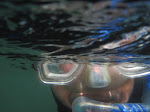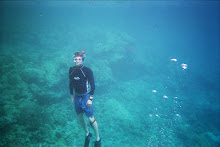Broad is a Pulitzer-Prize-winning science writer, who had two books on Stars Wars Weapons Systems under his belt before he shifted from sky-high to ocean-deep. The deep sea is one of the last territories on Earth to be explored, and Broad brings us up to date (into the 90s, anyway) through interviews, explanations, and some adventuring of his own. My favorite chapter, which I could excerpt for English 1A or for an aquatic-literary elective, is "Canyon," an in-depth look at the vast submarine canyon in our nearby Monterey Bay. The Packard family and MBARI, the Monterey Bay Aquarium Research Institute, are the stars for this epic descent.
Carey, Robin. Baja Journey: Reveries of a Sea-Kayaker. College Station, TX: Texas A & M UP, 1989.
Carey is an English professor from the Pacific Northwest, on vacation in the waters of Baja Mexico, full of thoughts of Shakespeare, the local scenes, and human frailty: philosophical, but with groundedness, despite being all about the water.
After reading this book, I rented a kayak and explored Monterey Bay for a few hours. Yes, I spent a little thought on Shakespeare and I considered how much colder it was off Monterey than off Cabo San Lucas, but mostly I thought how getting closer to the surface of nature really can get you closer to yourself, in the best ways possible.
Carr, Archie. So Excellent a Fishe: A Natural History of Sea-Turtles. New York: Anchor, 1972.
Carr's book is the Bible for sea turtle science, at least for many people. My wife is now reading this book in preparation for her own trip to Costa Rica and to the specific turtle station in Tortuguero. Carr sets the bar high with this in-depth study. He also walks the reader through the developing body of knowledge as he and other researchers work to answer the questions that beset them. How do turtles know how to navigate? Must they return to the same beaches they were hatched on? Where do the turtles go while developing from hatchlings to young adults, since no one seems to know: And further questions. Carr reports what he learns, and he includes us in the learning process, which makes the book and enjoyable and worthy model for thinking and discovering the things of the world.
P.S. Since Carr's book was published in 1972, obviously there are more up-to-date treatments, but So Excellent a Fishe is foundational. If all you want is information, then pick a more recent book. Indeed you should--I should--read current material too. Carr's book takes you on the journey, and that's a compelling consideration, I hope. (As a further note, the more recent reprints reverse the subtitle and title, making the book easier to discover when looking for sea turtle material: A Natural History of Sea-Turtles.)



















